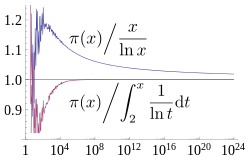চিত্র:Prime number theorem ratio convergence.svg

এই SVG ফাইলের জন্য এই PNG প্রাকদর্শনের আকার: ২৫০ × ১৬০ পিক্সেল। অন্যান্য আকারসমূহ: ৩২০ × ২০৫ পিক্সেল | ৬৪০ × ৪১০ পিক্সেল | ১,০২৪ × ৬৫৫ পিক্সেল | ১,২৮০ × ৮১৯ পিক্সেল | ২,৫৬০ × ১,৬৩৮ পিক্সেল।
পূর্ণ রেজোলিউশন (এসভিজি ফাইল, সাধারণত ২৫০ × ১৬০ পিক্সেল, ফাইলের আকার: ৮৭ কিলোবাইট)
ফাইলের ইতিহাস
যেকোনো তারিখ/সময়ে ক্লিক করে দেখুন ফাইলটি তখন কী অবস্থায় ছিল।
| তারিখ/সময় | সংক্ষেপচিত্র | মাত্রা | ব্যবহারকারী | মন্তব্য | |
|---|---|---|---|---|---|
| বর্তমান | ১৩:০৭, ২১ মার্চ ২০১৩ |  | ২৫০ × ১৬০ (৮৭ কিলোবাইট) | Dcoetzee | Change n to x to match article |
| ১২:৩০, ২১ মার্চ ২০১৩ |  | ২৫০ × ১৬০ (৮৬ কিলোবাইট) | Dcoetzee | Convert formula from graphics to pure SVG using http://www.tlhiv.org/ltxpreview/ | |
| ১২:২৩, ২১ মার্চ ২০১৩ |  | ২৫০ × ১৬০ (১৩০ কিলোবাইট) | Dcoetzee | {{Information |Description ={{en|1=A plot showing how two estimates described by the prime number theorem, <math>\frac{n}{\ln n}</math> and <math>\int_2^n \frac{1}{\ln t} \mathrm{d}t = Li(n) = li(n) - li(2)</math> converge asymptotically towards <ma... |
সংযোগসমূহ
নিচের পৃষ্ঠা(গুলো) থেকে এই ছবিতে সংযোগ আছে:
ফাইলের বৈশ্বিক ব্যবহার
নিচের অন্যান্য উইকিগুলো এই ফাইলটি ব্যবহার করে:
- ar.wikipedia.org-এ ব্যবহার
- ca.wikipedia.org-এ ব্যবহার
- el.wikipedia.org-এ ব্যবহার
- en.wikipedia.org-এ ব্যবহার
- fa.wikipedia.org-এ ব্যবহার
- he.wikipedia.org-এ ব্যবহার
- hu.wikipedia.org-এ ব্যবহার
- hy.wikipedia.org-এ ব্যবহার
- id.wikipedia.org-এ ব্যবহার
- ja.wikipedia.org-এ ব্যবহার
- no.wikipedia.org-এ ব্যবহার
- pl.wikipedia.org-এ ব্যবহার
- sl.wikipedia.org-এ ব্যবহার
- sr.wikipedia.org-এ ব্যবহার
- sv.wikipedia.org-এ ব্যবহার
- ta.wikipedia.org-এ ব্যবহার
- vi.wikipedia.org-এ ব্যবহার



